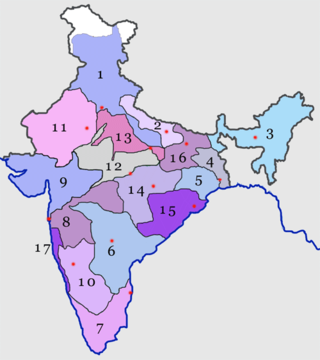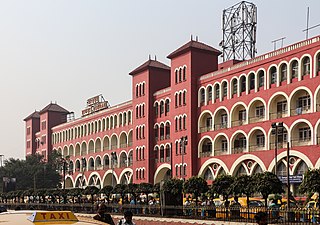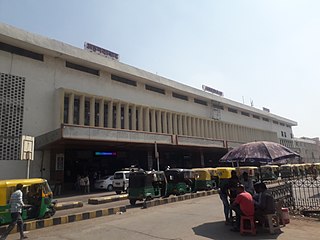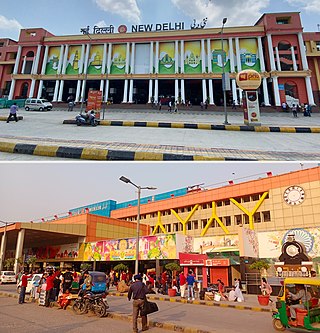
The London Underground is a rapid transit system serving Greater London and some parts of the adjacent home counties of Buckinghamshire, Essex and Hertfordshire in England.

The East Japan Railway Company is a major passenger railway company in Japan and is the largest of the seven Japan Railways Group companies. The company name is officially abbreviated as JR-EAST or JR East in English, and as JR Higashi-Nihon in Japanese. The company's headquarters are in Yoyogi, Shibuya, Tokyo, and next to Shinjuku Station. It is listed in the Tokyo Stock Exchange, is a constituent of the TOPIX Large70 index, and is also one of the three only Japan Railways Group constituents of the Nikkei 225 index, the other being JR Central and JR West.

Indian Railways (IR) is a statutory body under the ownership of the Ministry of Railways, Government of India that operates India's national railway system. It manages the fourth largest national railway system in the world by size, with a total route length of 68,043 km (42,280 mi), running track length of 102,831 km (63,896 mi) and track length of 128,305 km (79,725 mi) as of 31 March 2022. 58,812 km (36,544 mi) of all the gauge routes are electrified with 25 kV 50 Hz AC electric traction as of 1 April 2023.

Lahore Junction Railway Station, is the main railway station in Lahore, Pakistan. Construction commenced shortly after the 1857 War of Independence and so was built in the style of a medieval castle with thick walls, turrets, and holes to direct gun and cannon fire for defence of the structure.

The Western Railway is one of the 19 zones of Indian Railways and is among the busiest railway networks in India, headquartered at Mumbai, Maharashtra. The major railway routes of Indian Railways which come under Western Railways are: Mumbai Central–Ratlam, Mumbai Central–Ahmedabad and Palanpur–Ahmedabad. The railway system is divided into six operating divisions: Ahmedabad, Vadodara, Rajkot, Bhavnagar, Ratlam, and Mumbai WR. Vadodara railway station, being the junction point for the Ahmedabad–Mumbai route and the Mumbai–Ratlam route towards New Delhi, is the busiest junction station in Western Railways and one of the busiest junctions of Indian Railways too, while Ahmedabad Division earns highest revenue followed by Mumbai Division and Vadodara Division. Surat railway station is one of the busiest railway station in Western Railway in non-junction category where more than 180 trains pass per day.

New Jalpaiguri Junction railway station established in 1960, is an A1 category broad gauge and narrow-gauge railway station under Katihar railway division of Northeast Frontier Railway zone. It is the largest as well as the busiest railway junction of Northeast India. This junction is largest among the railway stations which serves the city of Siliguri, the largest metropolis of the North Bengal. The other stations are- Siliguri Junction, Gulma, Bagdogra, Matigara, Rangapani and Siliguri Town. New Jalpaiguri junction ranked 10th cleanest railway station in India in 2016 survey and came among the top 100 booking stations of Indian railway. New Jalpaiguri, as a railway station serves as the entry point to North Bengal, Sikkim, other countries like Nepal, Bhutan, Bangladesh and the seven northeastern states. New Jalpaiguri Junction acts as a connecting base for the Northeastern states to the Indian mainland.

Howrah Railway Station is a railway station located in the city of Howrah, West Bengal, India. It is the oldest, largest and busiest railway complex in India as well as one of the busiest and largest train stations in the world. Howrah is one of six intercity train stations serving the Kolkata metropolitan area, the others being Sealdah, Dankuni, Santragachi, Shalimar and Kolkata railway station.

A side platform is a platform positioned to the side of one or more railway tracks or guideways at a railway station, tram stop, or transitway. A station having dual side platforms, one for each direction of travel, is the basic design used for double-track railway lines. Side platforms may result in a wider overall footprint for the station compared with an island platform where a single width of platform can be shared by riders using either track.

Ahmedabad Junction railway station is the main railway station of Ahmedabad, Gujarat, India. It is also the biggest railway station within Gujarat and also one of the major railway station in India. It is the highest income-generating division in Western Railways. It connects to Mumbai, Chennai, Delhi, Howrah and other major cities of India. Also it is central railway station of Gujarat which connects to Saurashtra, Kutch, Vadodara, Surat, Himmatnagar, Bhavnagar, Palanpur, etc.

Hazrat Nizamuddin railway station is a railway station in South Delhi, India. It is under the administrative control of the Delhi Division of the Northern Railway zone of the Indian Railways. It is one of the five main stations in Delhi and handles nearly 250 trains daily The station was named after the Sufi saint Hazrat Nizamuddin. Hazrat Nizamuddin station was upgraded to help relieve congestion at New Delhi railway station and is recommended for first-time travellers, particularly those bound for Agra, as it is less busy and easier to navigate.

Delhi Junctionrailway station is the oldest railway station in Old Delhi, Delhi, India. It is one of the busiest railway stations in India in terms of frequency. Around 250 trains start, end, or pass through the station daily. It was established near Chandni Chowk in 1864 when trains from Howrah, Calcutta started operating up to Delhi. Its present building was constructed by the British Indian government in the style of the nearby Red Fort and opened in 1903. It has been an important railway station of the country and preceded the New Delhi by about 60 years. Chandni Chowk station of the Delhi Metro is located near it.

Krantivira Sangolli Rayanna (Bengaluru Station), commonly known as KSR Bengaluru Station, Bengaluru City Railway Station or Bangalore City Railway Station or Majestic Railway station (station code: SBC), is the main railway station serving the city of Bengaluru, Karnataka, India. It is the busiest railway station in South Western Railway zone of Indian Railways, and is the only station classified under NSG1 category in the zone.

Varanasi Junction railway station, also known as Varanasi Cantt railway station, is the main railway station serving the city of Varanasi. The other key railway stations in Varanasi Metro area are Banaras, Varanasi City, Kashi and Pandit Deen Dayal Upadhyaya Junction. The junction station is sandwiched between the cantonment region and Chetganj region of the city. The station is partially controlled by the Lucknow Division of the Northern Railway Zone and the Varanasi Division of the North Eastern Railway Zone of the Indian Railways. Varanasi Junction railway station nearly reaches the frequency of 300 trains daily. Almost, 45 trains originate and terminate at the station. Premium trains of Indian Railways also originate from Varanasi Junction, such as Vande Bharat Express and Mahamana Express

Bhopal Junction railway station is a major railway junction of India and main railway station of Bhopal, the capital of the central Indian state of Madhya Pradesh. This station also serves as a connecting point for various pilgrims from Asia to visit the Stupa of Sanchi, an important Buddhist stupa, which is about 40 kilometres (25 mi) from this station.

A train station, railway station, railroad station, or railway depot is a railway facility where trains stop to load or unload passengers, freight, or both. It generally consists of at least one platform, one track, and a station building providing such ancillary services as ticket sales, waiting rooms, and baggage/freight service. If a station is on a single-track line, it often has a passing loop to facilitate traffic movements.

Lucknow Charbagh is the largest and busiest railway station of Lucknow city. In 19th century, the next important station in the north after Delhi was Lucknow. It was the headquarters of the Oudh and Rohilkhand Railway (O&RR) whose first line from Lucknow to Kanpur was built in April 1867.

New Delhi railway station is the main railway station of the Indian capital of New Delhi. Platform 1 is located at Paharganj and platform 16 opens up on to the side of Ajmeri Gate. The station is in Central Delhi, about two kilometres (1.2 mi) north of Connaught Place in New Delhi. It is one of the busiest railway stations in the country in terms of train frequency and passenger movement.

Pandit Deen Dayal Upadhyaya Junction, formerly known as Mughalsarai Junction, is a railway station in the town of Mughalsarai in the Indian state of Uttar Pradesh. The station contains the largest railway marshaling yard in Asia. This yard caters to around 450–500 trains in a month. All trains, including premium category Rajdhani and Duronto trains, halt at this station, which makes it unique in the entire Indian Railways network. Major installations in Mughalsarai include electric locomotive shed holding 147 locomotives, diesel locomotive shed holding 53 locomotives, wagon ROH shed, and a 169-bed divisional hospital.




















